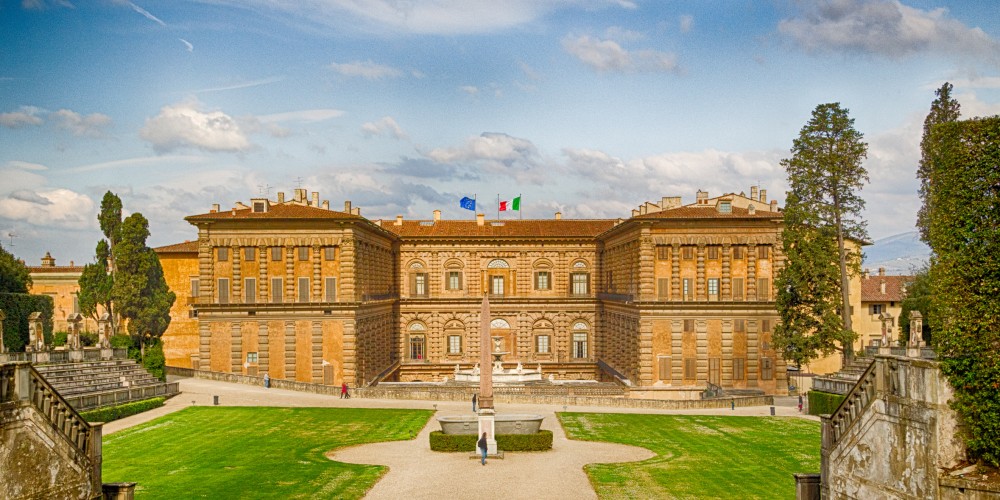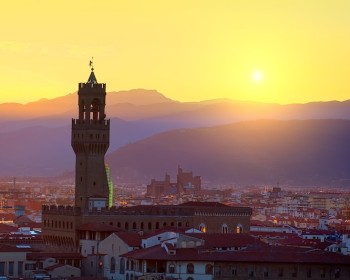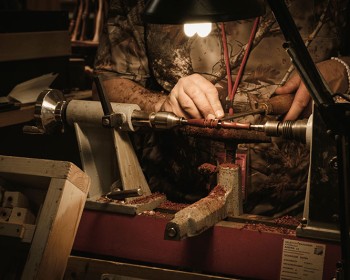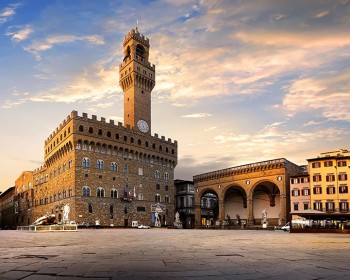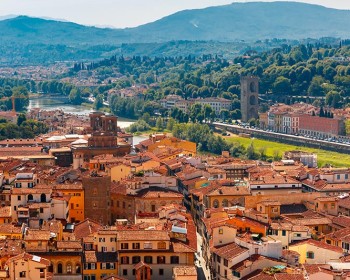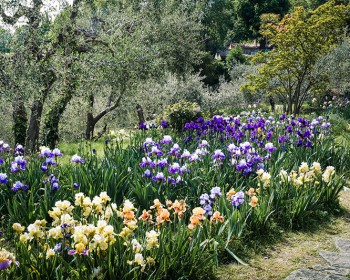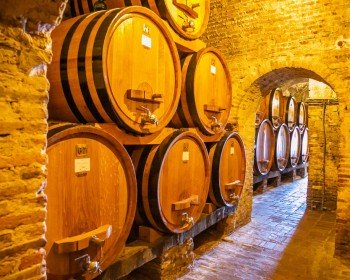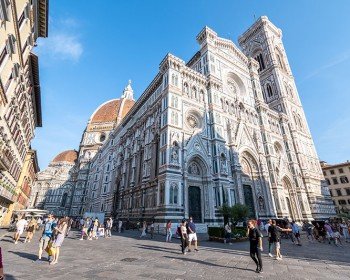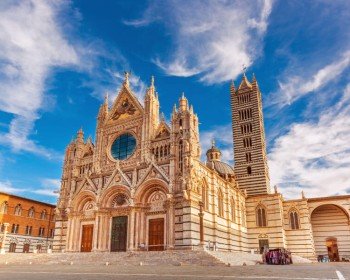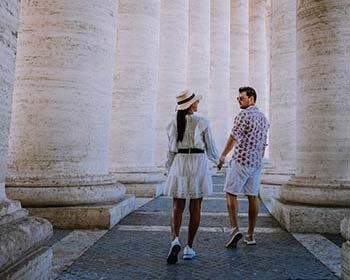Calling them simply “Boboli Gardens” could be misleading: this huge green space is so much more than a simple garden. Boboli Gardens in Florence are one of the biggest and most elegant Italian style gardens, an authentic monumental park: to visit it all you’ll need at least 3 hours!
These gardens, which hold in their green arms the historical Pitti Palace, are a real open-air museum. Its statues, fountains, builings and ancient trees were an inspiration for several other european gardens, such as the one in the of Palace of Versailles!
History of the Boboli Gardens in Florence
The Boboli Gardens reached their current appearance only after several stages of enlargements and addictions, which were carried out at different times, from the 15th to the 20th century. The first works on the park affected the area closer to the palace: this happened after the building had been purchased by Cosimo I de´ Medici and his wife Eleonora di Toledo, who chose this place for their new grand ducal palace. The first plan for the gardens was designed by Niccolò Tribolo, though the works were completed after his death, by other architects, including the famous Giorgio Vasari, Ammannati and Buontalenti.
The Boboli Gardens in Florence continued to be enlarged and enriched by the Medici and the Lorraine families, which altered and embellished the gardens through the 17th, 18th and 19th centuries. They became a real open-air museum, hosting statues dating to Ancient Rome and the Renaissance Period.
What to see in the Boboli Gardens
Once you enter the Boboli Gardens you will recognize different main areas: the Amphitheatre, the Viottolone, the Knight’s Garden, the Tower of the Koffeehouse and the Great Grotto.
Let’s find our what’s special about each area:
Amphitheatre
Walking past the monumental Court of Ammannati, just behind Pitti Palace, you’ll have to walk up a big staircase which will lead you to the Fountain of the Artichoke. There is no real artichoke reproduced in this fountain: its base is actually made from a bronze lily, but Florentines of the time disapproved of its appearence and said it resembled a giant artichoke!
From this moment on you will be left in the amphitheatre (which is actually a part of an old hippodrome). This monument was created through excavations made on the hill behind the Pitti Palace, an hill which had been used in the past as a cave to extract a particular kind of sandstone, called “pietraforte”. In the middle of this wide area you can admire a huge (and very heavy!) obelisk which was taken away from Luxor, in Egypt, and brought in the Boboli Gardens in 1789.
Two more highlights in the Amphitheatre are the Fountain of Neptune, the God of the Sea holding its trident, and the beautiful statue of a woman. It is dedicated to Abundantia, the goddess of prosperity, and it was created by sculptor Giambologna, who was inspired by the wife of Francis I of France, Joanne of Austria.
The Viottolone and the Isolotto
The name Viottolone literally means “wide avenue”: it is in fact a series of terraces all leading to a large central street. Walking down the Viottolone you will reach Porta Romana. A complex system of green galleries, covered with holm oaks leaves, was created to offer the Garden’s owners and their hosts a cosy and covered place to be used for conversation, reading and listening to the music played by Court’s musicians.
Walk down the avenue and its beautiful cypresses and admire the Isolotto oasis. This is an oval shaped island enclosed in a pond, which hosts the Fountain of Oceanus created by Giambologna. The fountain is surrounded by three more statues, which were inspired by three of the widest rivers in the world: Ganges, Nile and Euphrates. If you look closer you will also be able to see a statue of Perseus and his horse emerging from the water of the lake. Another stunning statue represents Andromeda, chained to a rock.
The Knight’s Garden
The Giardino del Cavaliere (Italian for Knight’s garden) is a walled garden, located on one of the highest point of the Boboli gardens. The name comes from the location: it was built over a bastion that is part of the fortifications of the city built by none other than Michelangelo! In this garden low hedges surround rare species of roses and dahlias and a fountain is located in its centre. The fountain is sometimes called “of the Monkey” because of the three bronze monkeys which sit at its base. In the Knight’s Garden there is also a nice building, called the Casino del Cavaliere. The building now hosts the Museum of Porcelain, which contains an amazing collection of porcelains coming from all over Europe: we really suggest you get inside to pay it a visit! Under the Knight’s Garden there is a large water tank: this is the starting point of the irrigation system which serves the whole garden. Boboli Gardens had in fact a state of the art irrigation system, one of the most complex and effective systems of their time!
Kaffeehouse and Lemonhouse
The house of the Lorraine made further additions to Boboli Gardens in the 18th century: the “Kaffeehaus”and the “Lemon House”, both built by Zanobi del Rosso, were among the most beautiful. The Kaffeehouse, with its light green walls, was built to offer the owners a quiet place to sip coffee: drinking the black liquid was one of the biggest fashions of the 18th century! The Kaffeehouse was closed for many decades and only re-opened to the public in 2013, after a long restoration work: enter and admire its beautiful frescoes is a must.
Great Grotto (Grotto of Buontalenti)
The building of the grotto was ordered by Francis I Medici and was executed by Bernardo Buontalenti. Two columns mark the entrance of the grotto: on the side of each column there is a niche with two statues of Cerere and Apollo.
The grotto is impressive for its mix of artistic forms: amazing sculptures, paintings and architectural elements are part of a collection which fills three different rooms.
The cave originally had impressive water-work displays (no longer in function today) and several statues, bas-reliefs and frescoes, created by the biggest artists of the time (Michelangelo, Bandinelli, Vasari and Giambologna).
Grottos were an important feature of Italian gardens in the 16th century: the aim was to recreate a real cave using artificial stalagmites and stalactites, images of animals and wall murals to reproduce the sky and nature, and also water-works to recreate the dampness of a real cave. The Grotto of Buontalenti is one of the first examples of this fashion.
Morgante the Dwarf
End your tour of the Boboli Gardens in Florence with a visit to the statue of the Dwarf Morgante! This statue appears on The Bacchino fountain (the word “Bacchino” comes from Bachus, the Greek god of wine) and is located next to one of the garden’s exits (the one that will lead you to Piazza Pitti). Morgante is a sculpture of a funny fat dwarf, sitting on a turtle: it was inspired by a real person, who was part of the court of Cosimo I de Medici and supposedly Cosimo’s favourite dwarf.
